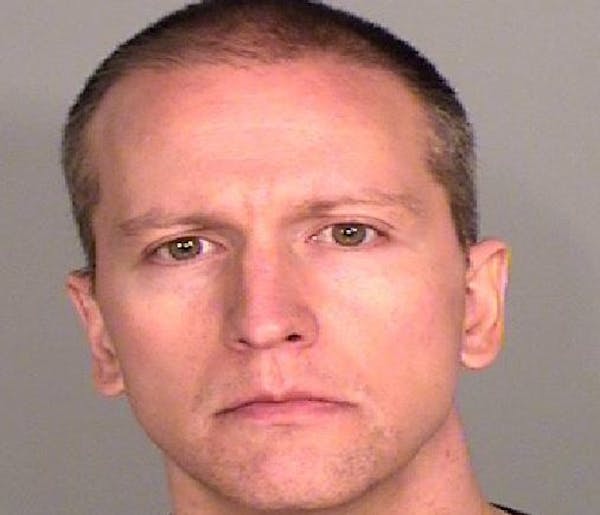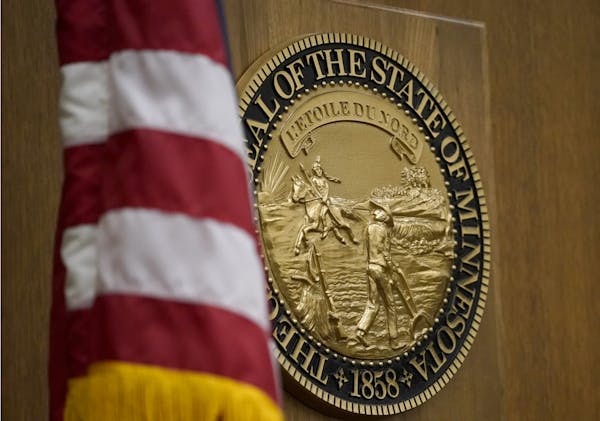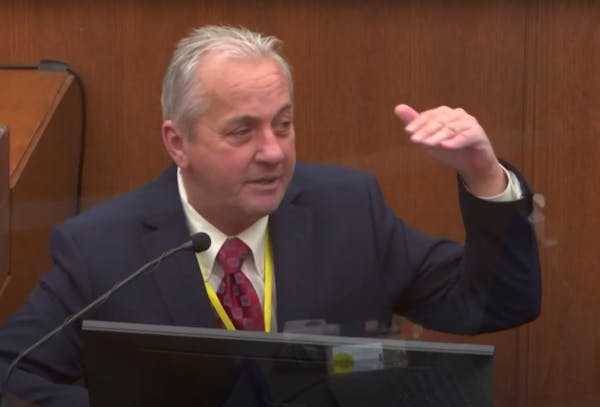The longest-serving officer in the Minneapolis Police Department testified Friday in Hennepin County District Court that the level of force used by ex-cop Derek Chauvin on George Floyd was "totally unnecessary" and dangerous.
Lt. Richard Zimmerman, the head of the department's homicide unit, was the second witness during a half-day session of court that closed out the first week of testimony in Chauvin's trial on charges of second- and third-degree murder and manslaughter. He was unequivocal when asked whether Chauvin's actions toward Floyd were appropriate.
"First of all," Zimmerman said, "pulling him down to the ground facedown and putting your knee on a neck for that amount of time is just uncalled for."
Zimmerman was the 19th witness over five days that included 12 eyewitnesses at the scene of Floyd's arrest and death in police custody on May 25. Friday's testimony, which included the introduction of still photos and short video clips, focused on procedure and routine, unlike the previous four emotional days of repeated viewings of the agonizing bystander video and the stories of tearful, traumatized witnesses.
In the first days of testimony, the 14 jurors and everyone else watching the global livestream saw multiple videos from police body-worn cameras and bystanders of Floyd's arrest in which he was pinned to the pavement on his stomach, handcuffed behind his back, for more than nine minutes, calling for his "mama" and saying he couldn't breathe, until he fell motionless and silent.
The fired officers who helped arrest and restrain Floyd, J. Alexander Kueng, Thomas Lane and Tou Thao, are scheduled to go on trial in August on charges of aiding and abetting second-degree murder and manslaughter.
Zimmerman, who has been with the Police Department since 1985 and in the homicide unit he now leads since 1995, went through the department's use-of-force policy, ranging from simply showing up to a scene and climbing all the way to deadly force.
He said department policy requires that prone suspects who are handcuffed — as Floyd was by Chauvin — must be taken off their chest as soon as possible. The position stretches the chest muscles and makes it difficult for someone to breathe, Zimmerman said.
Prosecutor Matthew Frank asked whether, in Zimmerman's opinion, the restraint should have stopped once Floyd was handcuffed and prone on the ground.
Zimmerman responded, "Absolutely."
Frank asked Zimmerman whether he had ever been trained to put a knee on the neck of someone in handcuffs.
"No, I haven't," he said.
Zimmerman said such a tactic would fall under the most extreme level of force by an officer, that being "deadly force."
"If your knee is on someone's neck, that could kill them," he said.
Frank then asked how much of a threat a suspect would be once handcuffed.
"The threat level goes down all the way," the lieutenant said. "They are cuffed; how can they hurt you? … [The threat of] you getting injured is way down," apart from possibly getting kicked, he continued.
Once the cuffs are on a suspect, Zimmerman said, "that person is yours. He is your responsibility. His safety is your responsibility. His well-being is your responsibility."
This wasn't the first time Zimmerman has been critical of the force used on Floyd. Shortly after Floyd's death, he was one of the officers who signed an open letter to the public, pledging to regain trust. The letter's signees said they "wholeheartedly condemn" Chauvin.
In court Friday, Zimmerman said Floyd posed no threat to the officers. "I saw no reason why the officers felt they were in danger, if that's what they felt, and that's what they would have to have felt to have to use that kind of force," he testified.
Under cross examination, defense attorney Eric Nelson noted that as an investigator, Zimmerman rarely has to use force compared with a patrol officer. Zimmerman also acknowledged under questioning that situations can be fluid, and officers must quickly adapt to what he called "scene security."
"You look at other things that may be hazards or threats, in the immediate vicinity, correct?"
"Yes."
"So you're gonna assess: Are there people watching, are there people videotaping, are those people happy or angry, etc., right?"
"Yes."
In a continued series of questions from Nelson about police training, Zimmerman acknowledged that police are first responders and not as medically trained as doctors or paramedics.
Nelson said that although Zimmerman testified he was never trained to use a knee on the neck of a suspect, officers are allowed "improvisation."
"You would agree, however, that in a fight for your life, generally speaking, you as an officer are allowed to use whatever force is reasonable and necessary, correct?"
"Yes."
"Minneapolis Police Department policy allows a police officer to use whatever means are available to protect himself or others, right?" Nelson asked.
Zimmerman agreed.
The lieutenant under questioning acknowledged that handcuffed suspects can still pose a danger.
"That person can continue to thrash his body around, agreed? And part of the reason police officers restrain people is for their own safety, agreed?" Nelson asked.
"Absolutely," Zimmerman said.
When prosecutors questioned Zimmerman again after the cross examination, Frank asked Zimmerman: "Did you see any need for Officer Chauvin to improvise by putting his knee on Mr. Floyd for 9 minutes and 29 seconds?"
"No, I did not," said Zimmerman.
Witnesses also heard testimony from Sgt. Jon Edwards, who was the night supervisor in the Third Precinct where Floyd was arrested.
After Floyd had been taken to HCMC from E. 38th Street and S. Chicago Avenue outside Cup Foods, both Zimmerman and Edwards were called to begin the "critical incident" investigation.
Edwards arrived first, about 9:30 p.m., an hour after Floyd was moved. Zimmerman arrived shortly after Edwards and was captured on body-worn camera played in court asking, "What's going on?"
Both Zimmerman and Edwards explained how they turned over the scene to state Bureau of Criminal Apprehension investigators once they learned Floyd had died at the hospital.
Zimmerman said he directed officers Kueng and Lane be taken downtown for debriefing.
Before Zimmerman took the stand Friday, Edwards, who has been an officer since 2007, said he was just beginning his shift that night of May 25 when he was alerted by the previous shift's supervisory sergeant that Floyd "may or may not live."
Edwards added that he was directed to the intersection where Floyd was arrested "just in case we had to secure that area and make contact with any of the officers" still there.
Arriving at the scene, he told Kueng and Lane to turn on their body-worn cameras. Prosecutors showed images of them in their squad as Edwards encountered them.
He said the officers pointed out where they interacted with Floyd. Edwards said he directed them to put up crime scene tape to "preserve any potential evidence that was there."
He ordered them out of their squad and looked for witnesses. He encountered Charles McMillian, one of the first to see Floyd being detained, who testified earlier in the week. At the time, McMillian refused to give Edwards his name.
"I told him he would be very valuable if he would provide us with information," Edwards said. "He told me he refused to say anything and wondered if he was under arrest; and I told him no, and he told me he wanted to leave."
Rochelle Olson • 612-673-1747
Paul Walsh • 612-673-4482
Chao Xiong 612-270-4708

Fired South High math teacher accuses Minneapolis Public Schools management of 'cancerous rot'

Over 27 years, couple have renovated Hopkins 'three-chimney house' built by Gluek family in 1939
Wanted man charged with posing as woman to lure men into sexually exploiting youngest of children



